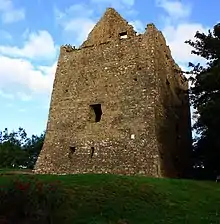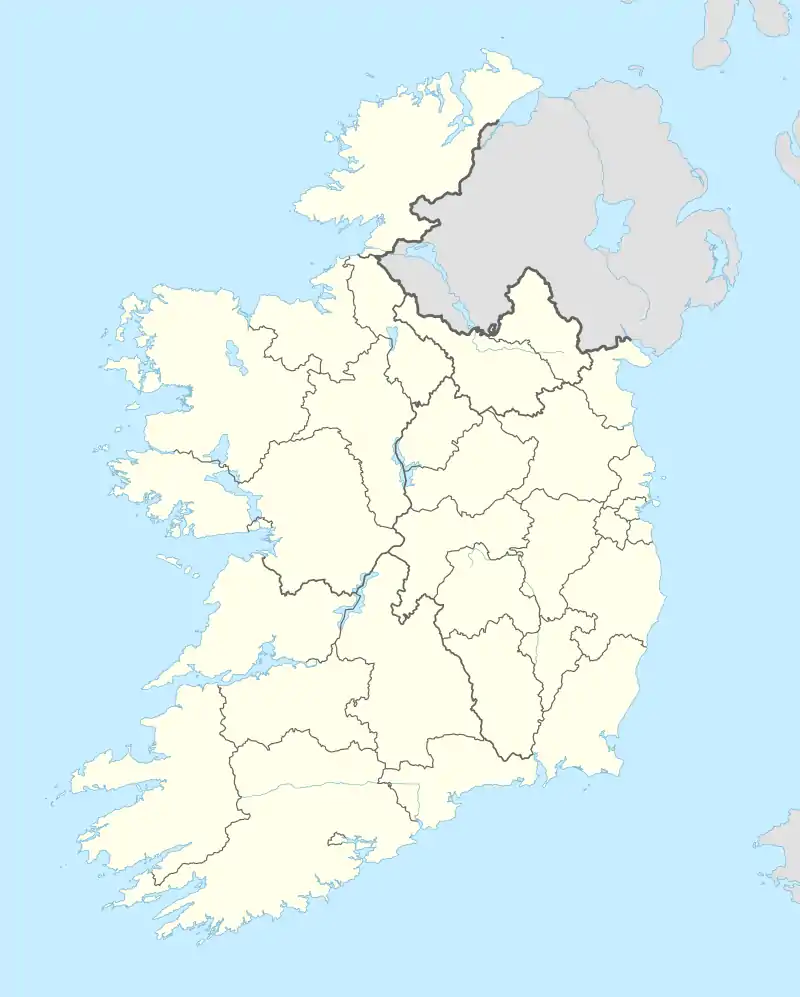Dunmore Castle
Dunmore Castle is a castle and National Monument located in County Galway, Ireland.[1][2][3]
| Dunmore Castle | |
|---|---|
| Native name Irish: Caisleán an Dúin Mhóir | |
 | |
| Type | keep (donjon) |
| Location | Castlefarm, Dunmore, County Galway, Ireland |
| Coordinates | 53.623756°N 8.755581°W |
| Built | 14th–16th century |
| Owner | State |
| Official name | Dunmore Castle |
| Reference no. | 248 |
 Location of Dunmore Castle in Ireland | |
Location
Dunmore Castle is located 1 km (0.62 mi) northwest of Dunmore, County Galway, on the north bank of the Sinking River.[4]
History
.jpg.webp)
Tradition states that Dunmore (Irish dún mór, "great hillfort") was a lesser residence of the ancient Kings of Connacht.[5]
The first castle at Dunmore was built by De Birmingham family in the early 13th century as a bulwark against Gaelic Irish attacks.
In 1249 Dunmore was attacked and burned by the Ó Conchubhair (O'Conors). In 1284 it was besieged by the Síol Maelruain under Fiachra O'Flynn.
In 1315 the castle was damaged by Rory O'Conor during the Bruce campaign in Ireland.
Most of the present structure dates from the early 14th century, i.e. the reigns of Edward II and III as Lords of Ireland: it was a two-storey hall keep. Dunmore Castle was modified in the 16th century, with extra floors, roof gables, chimneys, windows and a ground floor entrance.
The de Berminghams rebelled against Queen Elizabeth I and the castle was taken from them in 1569 by Sir Henry Sidney, Lord Deputy of Ireland, although it was later returned.[6]
The castle was seized from the de Berminghams permanently in the Cromwellian era (1650s).[7] It was occupied by the Ouseley family (including the famous preacher Gideon Ouseley) until the 19th century.[8][9][10]
A lime kiln was built on the site in the 19th century. The castle is at present under the protection of the Office of Public Works.
Description
The castle is a rectangular five-storey keep measuring 14 m × 8.2 m (46 ft × 27 ft) at base with a large base-batter.
There is evidence for a garderobe at the northwest. The windows include an oculus, mullions and arrowslits. Some of the curtain wall survives.[11]
References
- Sweetman, David (10 February 1999). Medieval Castles of Ireland. Collins Press. ISBN 9781898256755 – via Google Books.
- McNeill, T. E. (18 August 2005). Castles in Ireland: Feudal Power in a Gaelic World. Routledge. ISBN 9781134708864 – via Google Books.
- (M.A.), Gerard P. Moran (10 February 1996). Galway: History and Society. Geography Publications. ISBN 9780906602751 – via Google Books.
- "Dunmore Castle". historicsitesofireland.blogspot.ie.
- Spellissy, Sean (1 January 1999). The history of Galway. Celtic Bookshop. ISBN 9780953468331 – via Google Books.
- "Old Dunmore". www.askaboutireland.ie.
- "Dunmore Castle Dunmore County Galway Ireland". dunmore.galway-ireland.ie.
- "Dunmore Castle". landedestates.nuigalway.ie.
- "Ouseley". landedestates.nuigalway.ie.
- Harbison, Peter (10 February 2018). 'Our Treasure of Antiquities': Beranger and Bigari's Antiquarian Sketching Tour of Connacht in 1779 : Based on Material in the National Library of Ireland and the Royal Irish Academy. Wordwell. ISBN 9781869857530 – via Google Books.
- "Dunmore Castle, Co. Galway - Irish Archaeology". irisharchaeology.ie.
External links
